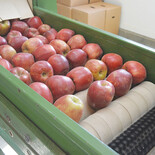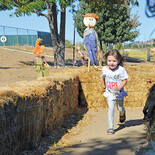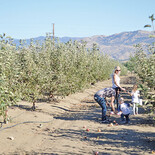The joys of Apple Season at Pulford Family Orchard
Family traditions run deep in Tehachapi, and with 35 years of the Pulford family growing apples it's become a tradition many families look forward to each year.
With around 2,500 trees and 19 varieties, harvesting begins in August and runs through the end of October to early November. Not all varieties are ready to harvest at the same time during the season and offerings may change week to week.
By Thanksgiving, the trees are dormant and it's time to begin the pruning process for the coming winter season of rain, mud and snow. Pruning, the art of cutting out older, less productive wood to encourage growth of new, more productive branches, takes place. Younger branches appear "whip" like, whereas older branches will be sturdier and more solid in appearance. Good symmetry is important, as is sunlight penetration.
By keeping trees smaller and more compact, ladders or lifts are not needed to harvest fruit and the trees are easier to maintain. In mid to late March trees wake-up, leaf out and begin to blossom. Weed control begins March, continuing into October. A "harrow", a tractor implement that is dragged, goes just deep enough into the earth to uproot surface roots for weed control of the orchard.
Pollination occurs naturally by wind and wild bees, but no bee boxes are brought in. Planted in blocks by variety, the most versatile pollen producing varieties are upwind to carry with the air current.
In June irrigation kicks off with two hoses to every tree row. The average apple tree is productive 50-60 years if maintained properly, and it takes a minimum of 2 years (some 3-4 years) to furnish an apple crop. Irrigation is accomplished through use of a well.

With 10 planted acres, frost is always a concern here in Tehachapi for outdoor crops. No smudge pots are in use for heating, and it's a "roll of the dice," remarks Andrew Pulford. One season 80% of the crop was lost that year. When this happens, they keep maintaining the trees in preparation for future years and harvests. It takes 120-180 days for an apple to become harvest-ready. For those apples lost, fallen fruit is reused in the form of nutrients by being turned under the earth to nourish the trees. Shanks, as they're called, open up the ground and allow for absorption of water and help with snow melt at the orchard.
During a typical day at the orchard
everything is sorted by 10 a.m. Good apples go through a machine where brushes clean dirt, foam rollers buff natural wax from the apple and a table rotates where workers pack boxes to ready for sale.
The first priority is the production of the produce; having an apple harvest. Following, is the agri-tourism aspect of sharing what the orchard does with the public. Andrew shares it's, "To give people an idea of what goes on," on a commercial basis of the food people buy.
The "harvest cycle" includes cleaning and packaging, the cooling process (34 degrees Fahrenheit) and transportation; getting food from production line to local market. Having the orchard open to the public helps people, "Get an idea of what it takes to produce our food," Andrew says.
Products offered at the orchard include high quality fresh apples, jams and apple butter, apple firewood bundles are also offered, great for BBQ and smoking rich flavor into meats.
Andrew's father, John, has been farming since he was a teenager. In school he studied agriculture, and he works in agriculture in the citrus industry in Bakersfield.
John and his wife Becky have farmed apples in two locations in Tehachapi over the past several decades. Their first orchard was a you-pick orchard on Goodrick Road. While the Goodrick orchard no longer exists, the orchard they've built and currently farm on Highline was planted in 1994.
Apples thrive in Tehachapi with the cooler climate. There once were 20-30 orchards operated in the Greater Tehachapi area. Now, there are only a handful of apple orchards with some that open to the public locally and others who grow solely for farmers markets in Southern California. Orchards change hands through the years.
The orchard takes a lot of work, Andrew admits. Over the years consumers have become disconnected from their food source. "People really appreciate having a place to come. With fewer places available, it creates a hunger for people to come here and connect."
From Bakersfield, Gary and Glenna Brown pile up their bounty to take home. "Empire Apples; we tried it last year for the first time and we've been waiting for it all year!" They shared with enthusiasm, "We've been watching their website!" They like using the apples and storing as slices for apple pie filling, freezing so they can enjoy them all year long.
For Andrew, his favorite apple dish growing up was sautéed apples on pancakes that his mother Becky made. Sliced thin, with a little bit of butter, and cooked to perfection in the sauté pan for 3-5 minutes, just enough to soften the apples. "It's delicious," he says, smiling.
At the orchard, they sell by volume not by weight. Container options include boxes, or various sizes of bags. Buying in bulk is a regular occurrence for customers to give to friends, clients, etc., out of the area as a special treat and an annual tradition. While harvesting by the public is now mainly for school groups, the orchard is open for business with boxed or bagged varieties.
Families have the tradition of coming here to pick apples and returning home to make apple butter, pie, apple sauce, etc., together as a family. Heirloom varieties that aren't as common in the grocery store have nostalgic value to visitors. People come from all over for the apples from Pulford family's orchard, including Bakersfield, Los Angeles and Las Vegas. "We have a visitor from Vermont who plans their trip around when the Winesap variety is ready for harvest," he says. "It's been their favorite variety since they were kids."
The orchard is something the Pulford family is both knowledgeable and passionate about, particularly in sharing the experience with others. "We really have strived to create a place people can come and enjoy learning about the apples and how they're produced." Andrew says, "To create and or carry on traditions of their own with their own families."
For hours and more information, visit their website at http://www.pulfordappletreeorchard.com
Quick guide to apple making:

Photo provided
Tehachapi locals Allison and Titus explore the rows of the apple orchard with their family.
• Apple Sauce: Use Jonagold and Melrose.
• Dehydrated Apple Chips: Use Mutsu.
• Juice and Cider: Use Red, Golden Delicious, and Jonagold.
• Pie: Use Braeburn, Melrose, Jonagold,
Jonathan, and Granny Smith.






